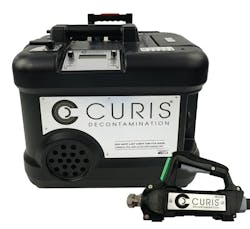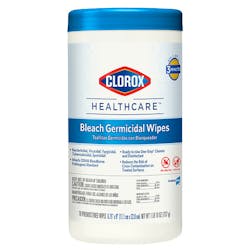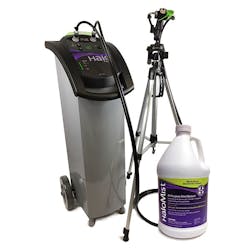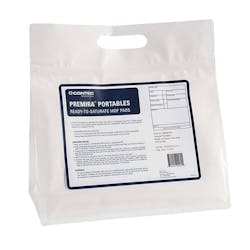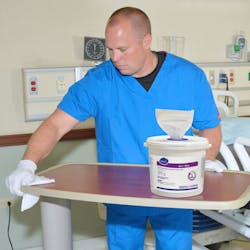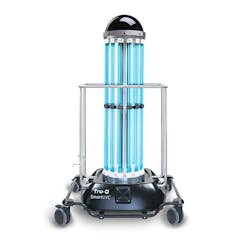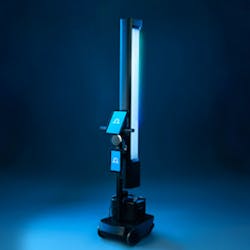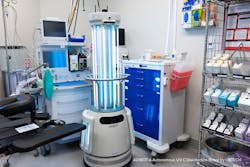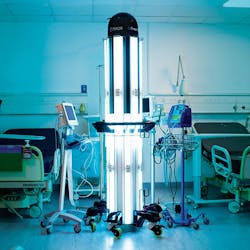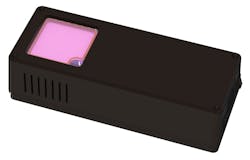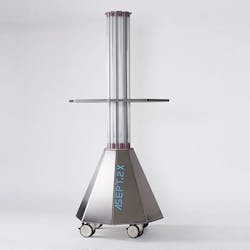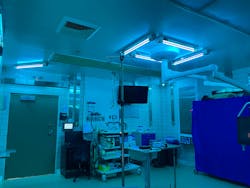Cleaning and disinfection of environmental surfaces is fundamental to reduce potential contribution to healthcare-associated infections,” states the U.S. Centers for Disease Control and Prevention (CDC). The agency goes onto add, “No single ‘blueprint’ exists for the best cleaning and disinfection method,”1 leaving hospitals to ask, “what is best for our facility?”
Here’s a look at some of the products and solutions available today to clean and decontaminate hospital rooms, information on their effectiveness, efficiency and safety, and comments from their manufacturers on what improvements may be needed in the future.
The battle against COVID, HAIs and emerging threats
As the old adage goes, “Better the devil you know than the devil you don’t.” Health systems and hospitals today are battling a broad range of well-known healthcare acquired infections (HAIs), the near endemic SARs-CoV-2, and emerging threats such as Monkeypox. Because nobody can predict what’s next around the corner, room decontamination that targets a broad range of dangerous microbes is top of mind for infection prevention.
Hands-free decontamination reaches high touch points
“Hospital rooms and surgical suites require high-level disinfection to minimize microbial contamination and protect patients against pervasive pathogens such as Candida auris and C. diff,” said Jeff Woodson, Product Manager, CURIS System. “Traditional manual cleaning often misses high touch point areas that can lead to dangerous HAIs or leave behind chemical residues that create a sticky environment for pathogens to cling to and grow.”
The CURIS 3 Hybrid Hydrogen Peroxide (HHP) fogging system helps eliminate these risks by providing hands-free automated disinfection through a powerful combination of vapor and micro-aerosolized hydrogen peroxide. It targets pathogens anywhere air touches, leaving behind no sticky or corrosive residues that can damage sensitive equipment like ventilators, computers and electronic devices.
The solution envelops each room in a hydrogen peroxide mist and maintains a dwell time to ensure no contaminated areas are left behind. Its hand sprayer attachment can be used to target high touchpoint areas in the room like bedrails and call bells.
“The CURIS 3 disinfection process is efficacious on even the toughest to kill hospital microbial threats like C. diff in a tri-part soil load with a 6-log reduction (99.9999%),” said Woodson. “CURoxide 7% H2O2 solution is an EPA-registered sporicidal disinfectant that is paired with the CURIS 3 device and is featured on Lists K, N, and Q for use against C diff., SARS-CoV-2, Monkeypox, and more.”
Pandemic lessons learned drive disinfection innovation
It has been two and half years since SARs-CoV-2, the virus responsible for COVID-19, took the healthcare world by surprise. Sharon Ward-Fore, MS, MT(ASCP), CIC, FAPIC, Infection Prevention Advisor, Metrex Infection Prevention, Envista Holdings Corporation, says the industry has learned some lessons, albeit the hard way.
“One thing we learned is that we must begin now to prepare for future outbreaks and pandemics,” said Ward-Fore. “One way to do this is to consider surface disinfectants that are Environmental Protection Agency (EPA) approved to meet the Emerging Viral Pathogens (EVP) claim. When rare or novel viruses, like SARs-CoV-2 and now Monkeypox, cause outbreaks of disease, there may be few if any disinfectants that have been tested and registered for use against these specific pathogens. This is how we prepare for the future.”
Metrex CaviWipes 2.0 fully qualifies for the EPA’s EVP claim for all virus types (enveloped, large and small non-enveloped viruses) to meet current and potentially future infection prevention needs, helping provide a safer environment for patients, staff and visitors. CaviWipes 2.0, which can be incorporated into daily room cleaning and disinfection, features:
- Enhanced efficacy claims against 61 pathogens including Norovirus, Candida auris, and multi-drug resistant organisms (MDROs).
- Excellent material compatibility with a neutral pH of 7.5, low alcohol content, and multi-pronged approach to attack and eliminate pathogens while remaining gentle on material surfaces.
- Easy to use label making it quick and easy to find critical efficacy, compatibility and safety information.
- Is bactericidal, tuberculocidal, virucidal and fungicidal with a 2-minute universal contact time.
Addressing HAIs throughout the healthcare continuum
“Outbreaks of new and re-emerging pathogens are adding additional pressure on healthcare facilities,” said Emily Rosenberg, MPH, Senior Specialist, Clinical and Scientific Affairs at CloroxPro. “Further, more care is moving to non-acute settings. Healthcare surface disinfectants need to be ready to meet the unique challenges facing infection preventionists and cleaning professionals across the healthcare continuum.”
“Clorox Healthcare solutions continue to improve to meet the needs in both acute and non-acute facilities,” Rosenberg continued. “Our ready-to-use solutions are designed to deliver fast surface disinfection efficacy and convenience for the ever-changing demands of the healthcare environment.”
Clorox Healthcare products have been formulated to meet the evolving healthcare landscape. Each of the ready-to-use, 1-step disinfectant wipes maintain fast disinfection efficacy while improving surface compatibility to help drive efficiencies across healthcare facilities without compromising patient safety.
Clorox Healthcare Bleach Germicidal Wipes are a convenient sporicidal surface disinfectant built to kill nearly 60 microorganisms in three minutes or less, including C. difficile and C. auris. They deliver an improved formulation maintaining fast disinfection efficacy when it matters most while improving surface compatibility and residue profile.
Clorox Healthcare Hydrogen Peroxide Cleaner Disinfectant Wipes are designed for use daily on common hospital surfaces. With better surface compatibility, less residue, and fast kill times, they are ideal for high-turnover areas.
Clorox Healthcare VersaSure Cleaner Disinfectant Wipes have low odor, low residue and high efficacy in a 2-minute, alcohol-free quat wipe. They are formulated for surface compatibility and offer the versatility to use everywhere, with the assurance of broad-spectrum disinfection.
The focus on whole-room disinfection
Over the past decade, healthcare professionals have increasingly recognized the importance of whole-room disinfection, according to Maryalice StClair, Chief Commercial Officer, Halosil International. She states:
“Awareness is improvement when it comes to room disinfection. Ten years ago, the concept of whole-room disinfection was unknown. Facilities of all kinds used only manual spray and wipe methods and it’s widely recognized that this is not sufficient to effectively reach and treat all surfaces against infection causing pathogens.”
“True whole-room surface decontamination must be exactly that, whole-room,” StClair continued. “This means every exposed surface must be treated, with no possibility to miss surfaces that aren’t always reached by electrostatic sprays or UV lights. Dry-mist fogging with the Halo Disinfection System reaches every surface, every time.”
The Halo Disinfection System provides EPA registered whole room sporicidal decontamination at the touch of a button using dry-mist hydrogen peroxide fogging that doesn’t wet surfaces, leave sticky residue, or harm electronics/supplies and requires no rinsing or wiping. Aerosolized HaloMist (5% H2O2, 0.01% silver ions) evaporates into a vapor to eliminate pathogens everywhere in a room, including floors, walls, ceilings, and all surfaces of complex equipment.
Touchless application makes room preparation simple and quick, saves on labor, and protects EVS staff from harmful chemicals. With no daily flushing or draining required, the system saves on disinfectant as well.
“Finally, affordability equals efficiency,” StClair added. “The Halo Disinfection System is the most affordable EPA registered dry-mist or vaporized hydrogen peroxide system on the market today.”
Decontamination in a world of shortages
Healthcare facilities have long been burdened with doing more with less. That has never been so true as today. Shortages in labor, supplies and natural resources are prompting facilities to rethink how they approach room decontamination.
Single-use disinfectant pads save time, labor, resources
“The current labor shortage and ongoing supply chain issues can make cleaning critical areas more difficult than in the past,” said Jane Easler, Marketing Manager, Contec. “Reducing water waste will continue to be a key issue for many facilities, especially for those in drought-affected areas.”
Premira Portables from Contec Professional is a simple yet effective way to help reduce cross-contamination when servicing floors. Each Portables pouch contains single-use Premira microfiber mop pads that can be saturated on demand.
“Premira microfiber mops feature a patented design that removes debris you can see (and the scary stuff you can’t) much better than cheap disposable mops,” Easler continued. “Simply pour the chemistry of your choice directly into the Portables bag and reseal it using the handy zip closure. Because the pouch is lightweight even when full of saturated mop pads, it’s easy to carry from room to room or area to area. There’s no need to pull out the heavy cleaning cart each time a floor needs to be cleaned or disinfected.”
An independent product life cycle analysis also showed that using Premira single-use mop pads wastes less water and energy than traditional laundered microfiber mop pads.
“Premira Portables can help reduce cross-contamination while contributing to positive patient outcomes and overall staff efficiency,” Easler added.
More efficient room turnover focused on patient safety
Larinda Becker, Executive Director of Marketing - Infection Prevention, Diversey, says facilities are looking for ways to simplify, streamline and standardize room turnover protocols, and having products and procedures that are compliant and effective is key.
“Emerging needs are to have products with shorter dwell times, effective against key pathogens of concern, including emerging viral pathogens, and products that are safer for users and patients,” said Becker. “Having these simplified product solutions that can be trained and implemented are more critical than ever.”
Diversey Perfect Turnover is an integrated program that makes it effective and efficient to turn over rooms for the next patient, without compromising quality. It includes products, best practice procedures, and training tools to help simplify, standardize, and execute cleaning and disinfection. The program’s validation tools help enhance performance based on objective measurements of cleaning and disinfection, which guide the cleaning and clinical staff for ongoing improvement refinement.
“Cleaning and disinfection solutions that save time and money are critical,” said Becker. “Examples include Oxivir wipes that are effective against a broad array of pathogens in 1 minute, or CleanPatch mattress and stretcher repair system can save money, waste and time.”
“Also, facilities continue to seek additional assurance of disinfection and deploying technologies, such as UV-C disinfection devices, which can provide the comfort of ensuring disinfection where surfaces may have been missed. Having the safest and most satisfying environment of care is the ultimate goal,” she added.
The realm of UVC in room decontamination
Ultraviolet-C (UVC) has been used for decades in the battle against microbes, to the point where UVC lamps are sometimes referred to as “germicidal” lamps.2
“Interest in ultraviolet-C (UV-C) irradiation as a strategy for decontaminating surfaces in the health care environment has skyrocketed during the COVID-19 pandemic,” states the U.S. National Institute of Standards and Technology (NIST).3
Today, healthcare facilities have a variety of UVC options to choose from when it comes to room decontamination, some of which leverage automation and robotics.
Disinfection documentation for the cleanest environments possible
“The UVC disinfection market has grown exponentially in the past five years as hospitals have been more receptive to adopting the technology and as health care facilities placed higher emphasis on cleanliness throughout the COVID-19 pandemic,” said Jennifer Picker, Director of Support Services and Program Development for Tru-D SmartUVC. “Now, more than ever, hospitals are realizing that it’s critical to provide the cleanest environments possible.”
The Tru-D device ensures significant microorganism inactivation in direct and shadowed areas, reducing human error in the disinfection process and documenting results for each cycle. Validated by more than 10 independent studies, the Tru-D device’s combined automated, measured dosing capabilities and real-time usage-tracking features make it one of the most advanced UVC disinfection systems available, according to the company.
“As the emphasis on providing the cleanest environment possible grows, hospitals will continue to seek out new ways to utilize technology in all areas of a facility. Further, as prominent organizations such as the AHA, the CDC and ASHE begin to stress the use of enhanced terminal room disinfection technology, I believe UVC disinfection will become a standard of care for health care facilities.”
The future of healthcare is autonomous
An Accenture survey found 71% of health executives believe robotics will enable the next generation of services in the physical world.4 Aaron Chau, OhmniLabs Product Manager & Team Lead, comments on how its OhmniClean autonomous UV-C disinfection robot improves room disinfection in the hospital environment.
“We developed OhmniClean to address a critical need in the healthcare market for fast, simple and effective disinfection. The future is autonomous, which is why OhmniClean uses autonomous tech to deliver more consistent disinfection without shadowing. The result is whole room coverage not a‑chievable by manual units.”
Chau notes how OhmniClean’s autonomous operation improves staff efficiency. Since the robot navigates on its own and does not require repositioning several times in one room, operators have more time for higher-level work. Its proprietary mapping technology, QuickMap, makes the robot easy to use; new operators can be trained in as little as five minutes.
Independent testing shows OhmniClean rapidly eliminates pathogens like MRSA, VRE, and SARS-CoV-2 with an efficacy of 99.999%, improving environmental and infection prevention standards aimed to combat HAIs.
Plus, auditable reports are available in real-time to demonstrate that proper disinfection has been completed. EVS directors, infection prevention specialists, and managers can immediately view data saved in the cloud through the company’s web-based portal.
“We’ve are privileged to work with EVS teams at major hospitals where staff members report faster turnaround times, less required labor, and an overall cleaner healthcare environment,” Chau said in closing.
Automated technologies address labor shortages
Healthcare facilities are increasingly adopting automated technologies to streamline workflows and room decontamination holds tremendous opportunities in this space. Ed Navarro, Director of Marketing, UBTECH North America, comments on how the company’s ADIBOT-A Autonomous UV-C Disinfection Robot boosts disinfection efficacy and efficiency.
“As workforce shortages continue in the healthcare space, the greater the potential for continuous tasks—those that require detail and attentiveness to prevent infections among staff and patients—to be less effective. Being able to set recurring disinfection runs scheduled at optimal times and with desired frequency, with minimal staffing or supervision required, and with high-efficacy rates, is where the ADIBOT-A really shines.”
“Both a tool and a robotic team member, the ADIBOT-A significantly improves efficacy and efficiency through state-of-the-art artificial intelligence,” Navarro commented. “The ability to move around patient and ORs using operator designated disinfection points, or AI self-mapped points, means it can provide 360-degrees of complete UV-C light coverage. This drastically mitigates the ‘shadowing’ effect where solid objects block the UV-C light from one side—an often-misunderstood limitation of UV-C light solutions using single disinfection points.”
“Included reporting tools offer valuable data to all involved in the infection prevention efforts,” said Navarro. “EVS teams, Infection Preventionists, and executive leadership will find information to help monitor usage, improve efficiency, and to make informed decisions.”
Eradicating pathogens in the shadows
“While surfaces and floors remain targets for enhanced cleaning, to effectively disinfect surface and air pathogens, UVC robots must both properly overcome obstacles that introduce variables in treatment. According to Brian Donahue, with Finsen Tech, “Shadows are our enemy; however, cross contamination is a specific hazard Finsen is trying to shed light on.”
“EVERY UVC robot casts a shadow underneath itself, ranging from 8 – 80 square feet.” says Donahue. “Pushing or driving a robot from one room to another increases risk of cross contamination. Some place additional items on the floor as part of their cleaning cycles, but all robots cast shadows, and boxy robots are particularly shady.”
Donahue stresses that dosage calculation must be calculated every cycle since room dimensions, contents, as well as relative placement of the robot can drastically change dosage calculation. “Be careful of systems that ignore these important factors in determining proper UVC dosage. Don’t believe that accurate cycle times can be calculated without accounting for these critical variables each cycle: power, distance, time and shadows.”
On demand UVC with fixed mount system
“More and more healthcare systems are turning to fixed mount UVC systems as an adjunct to their cleaning processes,” said Sam Guzman, Global Sales Director, American Ultraviolet. “These fully automated systems are operated by the existing staff with training available through an online portal.”
American Ultraviolet’s Fixed Mount UVC system achieves high levels of air and surface disinfection in minutes. Two taps on the touchscreen controller will run a fully automated disinfection cycle in under three minutes, which makes use in-between cases possible. The multiple fixtures delivering energy from the top-down limits or eliminates any shadows. Separate disinfection and procedure modes allow the facility the option to use the system during knee, hip or spine surgeries to lower the microbial load in the air and on surfaces while the wound site is exposed.
Casting light on air disinfection
Earlier this year, the Environmental Protection Agency (EPA) announced its Clean Air in Buildings Challenge to assist building owners and operators with reducing risks from airborne viruses and other contaminants indoors.5
“Global demand for clean, reliable disinfection has and always will be a crucial requirement, particularly following the emergence of COVID-19,” said John Yerger, CEO, Eden Park Illumination. “This move by the EPA further demonstrates the growing concern over improving indoor air quality for public health.”
“Far UV-C is a technology which is safe to operate in spaces occupied by people, due to the shorter wavelength range which prevents the UV rays from penetrating even the outermost layer of human skin or eyes,” Yerger explains. “Our MobileShield222 lamp provides safe and efficient disinfection of airborne pathogens. It is easy to use, right out of the box, and its compact, lightweight design makes it a portable solution. Far UV-C is the future of disinfection, creating a cleaner and safer world.”
High quality disinfection without the high cost
Cost, quality and outcomes are critical to hospitals in today’s value-based environment. Implementing room decontamination solutions to reduce the risk for HAIs can help hospitals achieve all three goals – lower costs from fewer HAIs, deliver higher care quality and achieve healthier clinical and financial outcomes.
Sanuvox Technologies provides high-performance air and surface disinfection systems of the highest quality, without high cost, says the company’s Chief Scientist Dr. Wladyslaw Kowalski, stating:
Dr. Kowalski says the company’s ASEPT.2X whole room disinfection units provide rapid disinfection of surfaces in less time than virtually any other system available. Its ASEPT.1X systems disinfect whole bathrooms or other rooms continuously when the rooms are unoccupied, and its S300 unit recirculates room air and removes in excess of 99.9% of airborne pathogens.
Customized UVC disinfection with intelligent design
Healthcare spaces vary broadly from waiting areas to surgical suites and, as defined by the CDC, from critical to non-critical items with regard to disinfection.6
“Every hospital is different. Cleanis believes that hospitals need customized disinfection solutions that are tailored to each hospital’s specific needs,” said De Ann Siebert, Product Manager, Cleanis. “More than 100 years of scientific research confirm the effectiveness of UVC disinfection, and no other method has been proven superior. Cleanis offers a wide range of customizable and economical UVC products.”
OR UVC disinfects surgical sites, between procedures and at automatically scheduled times. Mobile units are available in multiple size and cost options for terminal disinfection of patient rooms. Cleanis UVC products can also continuously reduce microorganisms in pharmacies, as well as open spaces like waiting rooms.
Cleanis UVC products are environmentally friendly and leave no chemicals, no ozone, no secondary contaminants, and no waste behind, so rooms are available for immediate use. Fast cycles improve room turnover time. Intelligent design makes its products easy to use, with safety features to protect against human error. Data analytics are available with some options. Cleanis is proud to say that all its UVC products are made in the USA.
The five UV-C must-haves for room decontamination
When asked how UVDI’s technology helps drive room decontamination effectiveness and efficiencies, the company’s Director of Global Marketing and Product Strategy Will Gerard stated:
“First, it starts with independently proven efficacy. Independently proven 99.99% inactivation of over 35 microorganisms in 5 minutes at 8 feet - and proven in-field efficacy in 15 published, hospital studies.
“Second, operational efficiency that fits into – as opposed to disrupts – hospital workflow. The UVDI-360 Room Sanitizer decontaminates an average patient room in 10 minutes.”
Fourth, 360° surface coverage confirmation technology during-and-after use to ensure all targeted surfaces have received a sufficient dose of germicidal UV-C.
“Fifth and foremost, the UVDI-360 is carefully designed for operator safety. Polymer-encapsulated UV-C lamps that will not shatter if broken. Long-range motion sensors immediately shut down the device if people are present. The device is lightweight at 88 lb for ease of mobility by Environmental Services professionals.”
With regards to what improvements in room decontamination he foresees happening in the future, Gerard added:
“Effective, enhanced environmental hygiene is possible today – and increasing in the future - without necessitating extra work. Technology enhancements that streamline operational steps and the amount of work required to get the job done. Advancements such as what we see in our homes more and more frequently – smart devices that automatically communicate with each other and humans to make things happen quickly.”
Refernces;
1. Reduce Risk from Surfaces, U.S. Centers for Disease Control and Prevention (CDC), https://www.cdc.gov/hai/prevent/environment/surfaces.html
2. UV Lights and Lamps: Ultraviolet-C Radiation, Disinfection, and Coronavirus, FDA, February 1, 2021, https://www.fda.gov/medical-devices/coronavirus-covid-19-and-medical-devices/uv-lights-and-lamps-ultraviolet-c-radiation-disinfection-and-coronavirus
3. NIST Journal: Special Section on UV Technologies for Public Health, U.S. National Institute of Standards and Technology (NIST), https://www.nist.gov/news-events/events/ultraviolet-disinfection-technologies-healthcare-associated-infections-defining
4. Robots in the Wild, Accenture, July 2020, https://www.accenture.com/us-en/insights/health/accenture-health-tech-vision-2020-robots-in-the-wild
5. EPA Announces the “Clean Air in Buildings Challenge” to Help Building Owners and Operators Improve Indoor Air Quality and Protect Public Health, EPA, March 17, 2022, https://www.epa.gov/newsreleases/epa-announces-clean-air-buildings-challenge-help-building-owners-and-operators-improve
6. A Rational Approach to Disinfection and Sterilization Guideline for Disinfection and Sterilization in Healthcare Facilities, Centers for Disease Control and Prevention (CDC), 2008, https://www.cdc.gov/infectioncontrol/guidelines/disinfection/rational-approach.html

Kara Nadeau | Senior Contributing Editor
Kara Nadeau is Sterile Processing Editor for Healthcare Purchasing News.

